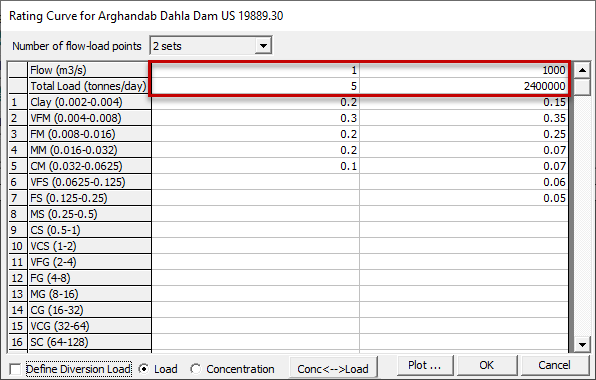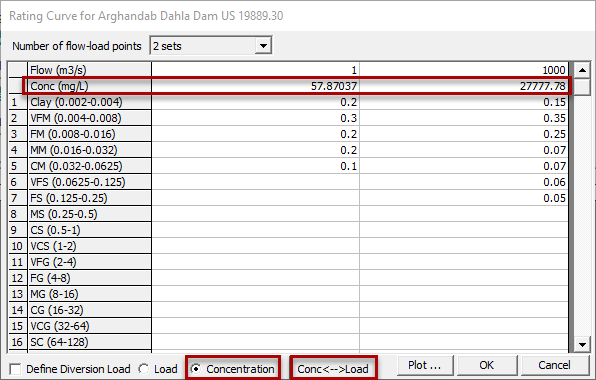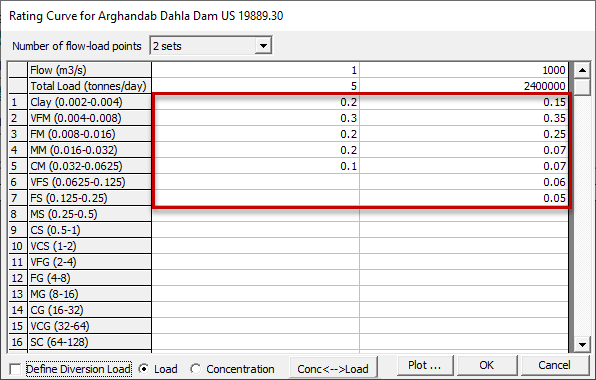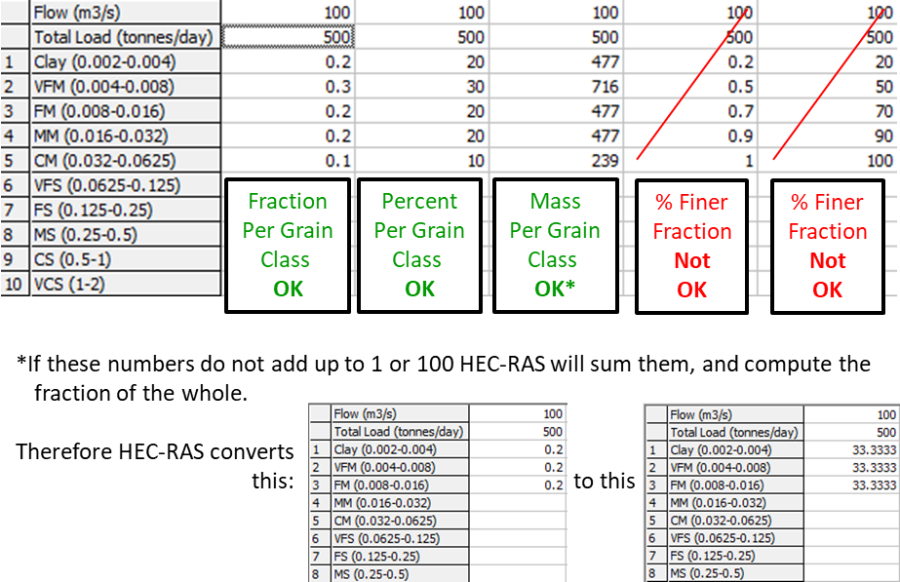Download PDF
Download page Rating Curve.
Rating Curve
A rating curve computes sediment boundary loads based on boundary flows. Select sediment Rating Curves at any cross section with a boundary flow series: upstream, lateral, or lateral uniform. The sediment Rating Curve boundary condition is always available for upstream boundaries. If the user selects an internal cross section in the Sediment Data editor Boundary Condition tab, the Rating Curve button will only activate if a selected internal cross section has an associated flow boundary condition. If a Rating Curve is associated with a Uniform Lateral Flow Series, HEC-RAS distributes sediment loads in the same proportion it distributes flow. This option will open the Rating Curve editor depicted in the figure below.

Flow-Load Data:
To correlate sediment loads with boundary discharge, the Rating Curve includes paired Flow-Load data. The number of columns, one for each Flow-Load pair, is set using the Number of flow-load points drop down box at the top of the dialog. Blank columns are not allowed. Select a range of flows that completely encompasses the flows expected during the simulation. If flows occur that exceed the upper bound of the rating curve, HEC-RAS will not extrapolate, but will use the largest sediment load specified in the table. HEC-RAS will interpolate loads below the smallest entered flow, assuming a zero-sediment load at zero flow. The Plot… button plots flow versus total load in log space.
New HEC-RAS Tool Downloads Data and Helps Develop Rating Curves
The latest version of HEC-RAS includes a Rating Curve Analysis Tool, that helps modelers download and analyze sediment load and gradation data to fill out this editor.
Flow-Concentration Data:
The rating curve editor uses load (mass/time) data by default. But users can also specify a sediment rating curve in Concentration units (mass/volume) (see figure below). Like particle size, Concentration is always in SI units in HEC-RAS (mg/L). To define a rating curve with Concentration data, click the Concentration Radio button on the bottom of the editor. ![]()
This radio button only defines the entered data as Concentration, it does not convert it. But the Conc↔Load Button allows users to move back and forth between concentration and Load.![]()

Modeling Note: Estimating a Flow-Load Curve from Noisy Data
Flow load data, if available, are usually noisy, spanning one or two orders of magnitude. Seasonal effects, non-stationarity, hysteresis, sample error and random processes make flow an imperfect predictor of load. Therefore, defining a single flow-load rating curve requires approximating the 'data cloud' with a single curve of flow-load points. Several considerations should guide flow-load estimation. Best practices in developing a sediment rating curve are discussed here, and several of them are described in the second half of this video:
Load-Gradation Data:
Each column of the sediment rating curve has a flow and an associated total load entered as mass per time (e.g. tons/day). Users must also specify the gradation of each of these sediment loads (below). (Note: These are incremental percentages or fractions not cumulative curves. (See figure titled, "Enter incremental (not cumulative or % finer) gradations in the rating curve editor.") Do not use %Finer conventions here.) Percentages (or decimal fractions) can be entered for each grain class for each load. If the total of the percentages (decimal fractions) does not equal 100 (or 1.0), HEC-RAS will normalize the total during computations (so that a given flow will produce the entered total load based on the ratios of the grain sizes).

Warning: Do Not Enter Cumulative Gradations in this Editor
This editor does not take cumulative % finer data. This causes confusion, because the bed gradation editor can take data either in % finer or %/fraction per grain class. Do not enter % finer data in the rating curve editor. These should be incremental fractions (e.g. 0.3) or incremental % (30) in each grain classes (below).
This video (starting at 8:34) describes two common errors we see in this editor.
Modeling Note: Estimating a Flow-Gradation
HEC-RAS requires precise gradational subdivisions of each boundary load in order to compute grain-class specific transport. However, these data rarely exist, and when they do they are usually either unhelpfully biased towards low flows that do little morphological work or are so noisy that it is difficult to infer a trend. Sediment load can also coarsen or fine with flow, making it difficult to estimate how to vary these data.Gibson and Cui (2017) "Flow Dependence of Suspended Sediment Gradations," Water Resources Research, 53(11), 9546-9563, doi.org/10.1002/2016WR020135 (proof) examined the flow-gradation relationships from 78 US gages and provide some guidance on estimating this parameter. But estimating this parameter is part of the 'art' of sediment transport modeling, combining data, system process understanding, scientific intuition, and engineering judgment. Because load gradation is among the least certain and most sensitive data, it often emerges as a target calibration parameter (Gibson and Pridal, 2015).